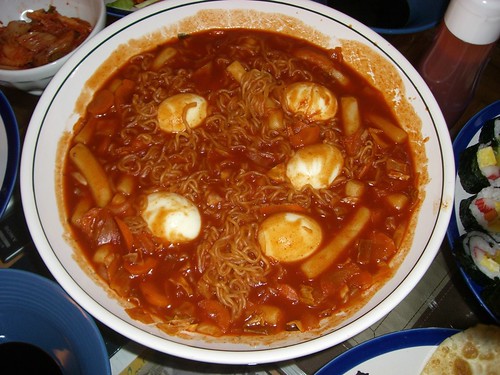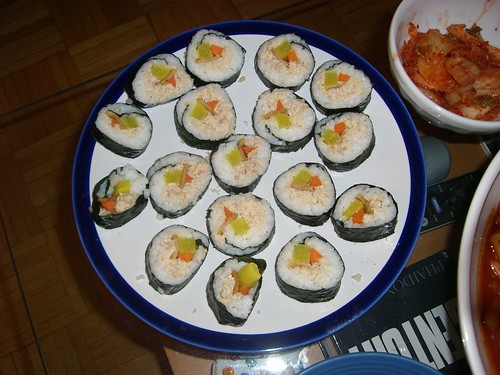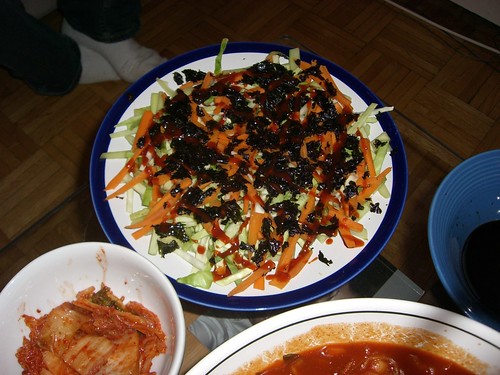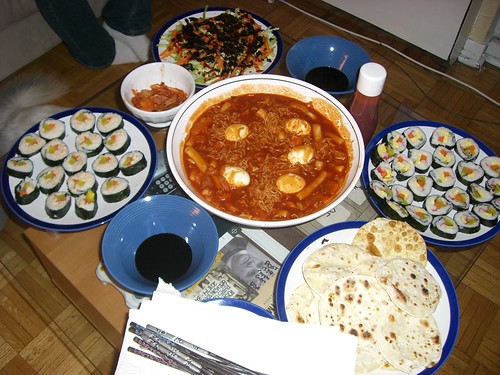And so you're excited to come back to Toronto knowing there's a couple Korea towns that can remind you of the good ole days in Korea. There's plenty of restaurants that will serve Korean food just like it was in Korea. Right? Well, not really. Upon coming back to Toronto, Dawna and I haven't really found any Ddukboki, Gimbap or Bibim Mandu that was quite as delicious as it was in Korea.
So what to do but take it upon yourself to create the delicious masterpiece?
Ladies and gentlemen... my attempt at Korean food. Part Uno.

Ddukboki (or so I think it's spelt)
This particular spicy dish was made of rice sticks (dduk), carrots, cabbage, onion and a few hard boiled eggs. Oh, we also tossed in some thin noodles (ramien)... so some may call this a ramboki The red sauce is hot pepper paste (or gochujang).
To make, you mix 1.5TBSP of gochujang with 1TBSP ketchup. Add about another 1TBSP of mulyeot (basically sugar/water/syrupy thing) and add as much water as necessary to show the consistency of this picture. Boil it, add the dduk. When the dduk is floating to the top, you add the vegetables and presto! Ddukboki.

Chumchi Gimbap (Chumchi means tuna.. gim means seaweed... bap means rice)
This would be the closest thing to Japanese sushi. It's basically seaweed, sticky rice and tuna (made with mayonnaise). You can also add strips of cucumber, carrot, pickled cabbage or anything else you'd like.
To make, you boil the sticky rice. Prepare the tuna. I would let the sticky rice cool off. Place the gim (or seaweed) on a flat surface. Take about 1.5TBSP of sticky rice and spread it evenly on the gim.. make sure you leave about an inch at the top free of sticky rice. Add a strip of tuna in the middle and any other toppings you'd like on top of the tuna. Now, it's time to roll it... so basically fold it from the bottom over the toppings, and start rolling... making sure it stays tight throughout the process. Carefully slice afterwards and you're done!

Bibim Mandu (I'm pretty sure bibim means mixed... and mandu means dumpling)
So this dish is layered with raw vegetables. You throw in some cabbage, cucumber and carrot, making sure they are all sliced thinly. Sprinkle some crushed/chopped up seaweed on top. Top with chogochujang (which is simlilar to the gochujang sauce used in ddukboki, but it's mixed with vinegar. If you've ever eaten bibimbap, that's the sauce that goes on top). That's the bibim part. The mandu part of the dish comes from the dumpling shell that you eat with it. You have to go out and buy something called "Mandu-P" which is basically just the shell or casing of Asian dumplings. They're flat.. and almost look like pancakes. You can either boil them or (very) lightly fry them. You basically take some of the veggie mix, put it on top of the pancake-looking mandu-p, roll it up and munch down. Very delicious.

That's the mandu-p in the bottom right corner. Make sure to serve this, as well as other Korean dishes with kimchi... the most popular snack/food for all Koreans. Kimchi is basically fermented/pickled/spiced cabbage. Korean food isn't Korean food without it.
How did it turn out? Not bad for a first timer!
- Gilad (is starving)
2 comments:
mmmmm! That looks awesome! There's a place in...hmm...North York I think called the house of noodles and dumplings, north of the 401 on younge st. I always topped there 'cause all the noodles are home made! MMMMMM!
I should not have looked at that whilst hungry...I want some!
Post a Comment